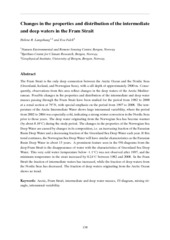Changes in the properties and distribution of the intermediate and deep waters in the Fram Strait
Peer reviewed, Journal article
Accepted version
Permanent lenke
https://hdl.handle.net/1956/5280Utgivelsesdato
2012-04Metadata
Vis full innførselSamlinger
- Geophysical Institute [1195]
Originalversjon
https://doi.org/10.1016/j.pocean.2011.10.002Sammendrag
The Fram Strait is the only deep connection between the Arctic Ocean and the Nordic Seas (Greenland, Iceland, and Norwegian Seas), with a sill depth of approximately 2600 m. Consequently, observations from this area reflect changes in the deep waters of the Arctic Mediterranean. Possible changes in the properties and distribution of the intermediate and deep water masses passing through the Fram Strait have been studied for the period from 1982 to 2008 at a zonal section at 79◦N, with special emphasis on the period from 1997 to 2008. The temperature of the Arctic Intermediate Water shows large interannual variability, where the period from 2002 to 2004 was especially cold, indicating a strong winter convection in the Nordic Seas prior to those years. The deep water originating from the Norwegian Sea has become warmer (by about 0.10◦C) during the study period. The changes in the properties of the Norwegian Sea DeepWater are caused by changes in its composition, i.e. an increasing fraction of the Eurasian Basin Deep Water and a decreasing fraction of the Greenland Sea Deep Water each year. If this trend continues, the Norwegian Sea DeepWater will have similar characteristics as the Eurasian Basin Deep Water in about 15 years. A prominent feature seen in the ΘS-diagrams from the deep Fram Strait is the disappearance of water with the characteristics of Greenland Sea Deep Water. This very cold water (temperature below -1.1◦C) was not observed after 1997, and the minimum temperature in the strait increased by 0.24◦C between 1982 and 2008. In the Fram Strait the fraction of intermediate waters has increased, while the fraction of deep waters from the Nordic Seas has decreased. The fraction of deep waters originating from the Arctic Ocean shows no trend.
